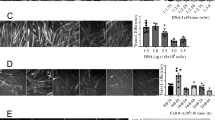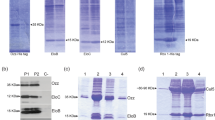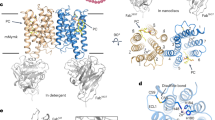Abstract
We have constructed a series of Escherichia coli expression vectors that produce high yields of fusion proteins containing the C–terminal fragment of light meromyosin (LMM) from rabbit fast skeletal muscle. The fusion proteins retain the ability of LMM to form polymers in low salt and to be soluble in high salt. Thus they can be easily purified from bacterial extracts with a high salt–low salt extraction procedure and still retain their biochemical properties. We demonstrate the utility of this system for the heterologous production and simple purification of LMM fusions of p21H–ras, the neurofibromatosis type I protein and the Tat and protease proteins of HIV–1.
This is a preview of subscription content, access via your institution
Access options
Subscribe to this journal
Receive 12 print issues and online access
$209.00 per year
only $17.42 per issue
Buy this article
- Purchase on Springer Link
- Instant access to full article PDF
Prices may be subject to local taxes which are calculated during checkout
Similar content being viewed by others
References
Amann, E., Brosius, J. and Ptashne, M. 1983. Vectors bearing a hybrid trplac. promoter useful for regulated expression of cloned genes in Escherichia coli. Gene 25: 167–178.
Remaut, E., Stanssens, P. and Fiers, W. 1981. Plasmid vectors for high efficiency expression controlled by the PL promoter of coliphage lamda. Gene 15: 81–93.
Tabor, S. and Richardson, C.C. 1985. A bacteriophage T7 RNA polymerase/promoter system for controlled expression of specific genes. Proc. Natl. Acad. Sci. USA 82: 1074–1078.
Marston, F.A.O. 1986. The purification of eucaryotic polypeptides synthesized in Escherichia coli. Biochem. J. 240 1–12.
Gray, M.R., Colot, H.V. and Rosbash, M. 1982. Open reading frame cloning: identification, cloning and expression of open reading frame DNA. Proc. Natl. Acad. Sci. USA 79: 6598–6602.
Koenen, M., Rüther, U. and Müller-Hill, B. 1982. Immunoenzymatic detection of expressed gene fragments cloned in the lacZ gene of Escherichia coli. EMBO J. 1: 509–512.
Rimm, D.L. and Pollard, T.D. 1989. New plasmid vectors for high level synthesis of eucaryotic fusion proteins in Escherichia coli. Gene 75: 323–327.
Uhlen, M., Nilsson, B., Guss, B., Lindberg, M., Gatenbeck, S. and Philipson, L. 1983. Gene fusion vectors based on the gene for staphylococcal protein A. Gene 23: 369–378.
Stanley, K.K. and Luzio, J.P. 1984. Construction of a new family of high efficiency bacterial expression vectors: identification of cDNA clones coding for human liver proteins. EMBO J. 3: 1429–1434.
Smith, D.B. and Johnson, K.S. 1988. Single-step purification of polypeptides expressed in Escherichia coli as fusions with glutathione S-transferase. Gene 67 31–40.
Guan, K. 1991. Eucaryotic proteins expressed in Escherichia coli: an improved thrombin cleavage and purification procedure of fusion proteins with glutathione S-transferase. Anal. Biochem. 192: 262–267.
Bedouelle, H. and Duplay, P. 1988. Production in Escherichia coli and one-step purification of bifunctional hybrid proteins which bind maltose. Eur. J. Biochem. 171: 541–549.
Maina, C.V., Riggs, P.D. Grandea, A.G. III, Slatko, B.E., Moran, L.S., Tagliamonte, J.A., McReynolds, L.A. and diGuan, G. 1988. An Escherichia coli vector to express and purify foreign proteins by fusion to and separation from maltose-binding protein. Gene 74: 365–373.
Maeda, K., Rösch, A., Maéda, Y., Kalbitzer, H.R. and Wittinghofer, A. 1991. Rabbit skeletal muscle myosin. Unfolded carboxyl-terminus and its role in molecular assembly. FEBS Lett. 281 23–36.
Kalbitzer, H.R., Maeda, K., Rösch, A., Maéda, Y., Geyer, M., Beneicke, W., Neidig, K.P. and Wittinghofer, A. 1991. C-terminal structure and mobility of rabbit skeletal myosin light meromyosin as studied by one- and two-dimensional 1H NMR spectroscopy and X-ray small-angle scattering. Biochemistry 30: 8083–8091.
Maeda, K., Sczakiel, G. and Wittinghofer, A. 1987. Characterization of cDNA coding for the complete light meromyosin portion of rabbit fast skeletal muscle myosin heavy chain. Eur. J. Biochem. 167: 97–102.
Amann, E. and Brosius, J. 1985. ‘ATG’ vectors for regulated high-level expression of cloned genes in Escherichia coli. Gene 40: 183–190.
Barbacid, M. 1987. ras genes. Ann. Rev. Biochem. 56: 779–827.
Tucker Sczakiel, G., Feuerstein, J., John, J., Goody, R.S. and Wittinghofer, A. 1986. Expression of p21 proteins in Escherichia coli and stereochemistry of the nucleotide-binding site. EMBO J. 5: 1351–1358.
Feuerstein, J., Goody, R.S. and Wittinghofer, A. 1987. Preparation and characterization of nucleotide-free and metal ion-free p21 “apoprotein”. J. Biol. Chem. 262: 8455–8458.
Poe, M., Scolnick, E.M. and Stein, R.B. 1985. Viral Harvey ras p21 expressed in Escherichia coli purifies as a binary one-to-one complex with GDP. J. Biol. Chem. 260: 3906–3909.
John, J., Frech, M. and Wittinghofer, A. 1988. Biochemical properties of Ha-ras encoded p21 mutants and mechanism of the autophosphorylation reaction. J. Biol. Chem. 263: 11792–11799.
Trahey, M. and McCormick, F. 1987. A cytoplasmic protein stimulates normal N-ras p21 GTPase, but does not affect oncogenic mutants. Science 238: 542–545.
Vogel, U., Dixon, R.A.E., Schaber, M.D., Diehl, R.E., Marshall, M.S., Scolnick, E.M., Sigal, I.S. and Gibbs, J.B. 1988. Cloning of bovine GAP and its interaction with oncogenic ras p21. Nature 335 90–93.
Gideon, P., John, J., Frech, M., Lautwein, A., Clark, R., Scheffler, J.E. and Wittinghofer, A. 1992. Mutational and kinetic analysis of the GTPase-Activating Protein (GAP)-p21 interaction: The C-terminal domain of GAP is not sufficient for full activity. Mol. Cell. Biol. 12: 2050–2056.
Martin, G.A., Viskochil, D., Bollag, G., McCabe, P.C., Crosier, W.J., Haubruck, H., Conroy, L., Clark, R., O'Connel, P., Cawthon, R.M., Innis, M.A. and McCormick, F. 1991. The GAP-related domain of the neurofibromatosis type 1 gene product interacts with ras p21. Cell 63: 843–849.
Xu, G., Lin, B., Tanaka, K., Dunn, D., Wood, D., Gesteland, R., White, R., Weiss, R. and Tamanoi, F. 1991. The catalytic domain of the neurofibrmatosis type 1 gene product stimulates ras GTPase and complements ira mutants of S. cerevisiae. Cell 63: 835–841.
Ballester, R., Marchuk, D., Boguski, M., Saulino, A., Letcher, R., Wigler, M. and Collins, F. 1991. The NF1 locus encodes a protein functionally related to mammalian GAP and yeast IRA proteins. Cell 63: 851–859.
Harrington, W.F. and Himmelfarb, S. 1972. Effect of adenosine di-and triphosphates on the stability of synthetic myosin filaments. Biochemistry 11: 2945–2952.
Oriol-Audit, C., Lake, J.A. and Reisler, K. 1981. Structural changes in synthetic myosin filaments and their dissociation by adenosine triphosphate and pyrophosphate. Biochemistry 20: 679–686.
Reisler, E., Cheung, P., Borochow, N. and Lake, J.A. 1986. Monomers, dimers, and minifilaments of vertebrate skeletal myosin in the presence of sodium pyrophosphate. Biochemistry 25: 326–332.
Arya, S.K., Guo, C.S.F. and Wong-Staal, F. 1985. Trans-activator gene of human T-lymphotropic virus type III (HTLV-III). Science 229 69–74.
Sodroski, J., Patarca, R., Rosen, C., Wong-Staal, F. and Haseltine, W. 1985. Location of the trans-activating region on the genome of human T-cell lymphotropic virus type III. Science 229 74–77.
Frankel, A.D., Bredt, D.S. and Pabo, C.O. 1988. Tat protein from human immunodeficiency virus forms a metal-linked dimer. Science 240 70–73.
Dingwall, C., Ernberg, I., Gait, M., Green, S.M., Heaphy, S., Karn, J., Lowe, A.D., Singh, M. and Skinner, M.A. 1990. HIV-I Tat protein stimulates transcription by binding to a U-rich bulge in the stem of the TAR RNA structure. EMBO J. 9: 4145–4153.
Weeks, K., Ampe, Ch., Schultz, S., Steitz, T. and Crothers, D. 1990. Fragments of the HIV-1 Tat protein specifically bind TAR RNA. Science 249: 1281–1285.
Nagai, K. and Thogersen, H.C. 1987. Synthesis and sequence-specific proteolysis of hybrid proteins produced in Escherichia coli.. Meth. Enzymol. 153: 461–481.
Tommasselli, A.G., Howe, W.J., Sawyer, T.K., Wlodawer, A. and Henrikson, R.L. 1991. The complexities of AIDS: an assessment of the HIV protease as a therapeutic agent. Chimicaoggi May, 1991.
Baum, F.Z., Bebernitz, G.A. and Gluzman, Y. 1990. Isolation of mutants of human immunodeficiency virus protease based on the toxicity of the enzyme in Escherichia coli. Proc. Natl. Acad. Sci. U.S.A. 87: 5573–5577.
Baum, E.Z., Bebernitz, G.A. and Gluzman, Y. 1990. β-galactosidase containing a human immunodeficiency virus protease cleavage site is cleaved and inactivated by human immunodeficiency virus protease. Proc. Natl. Acad. Sci. USA 87: 10123–10027.
Loeb, D.D., Swanstrom, R., Everitt, L., Manchester, M., Stamper, S.E. and Hulchinson, C.A. III Complete mutagenesis of the HIV-1 protease. Nature 340: 397–400.
Bischoff, F.R. and Ponstingl, H. 1991. Catalysis of guanine nucleotide exchange on ran by the mitotic regulator RCCI. Nature 354 80–82.
Pohlner, J., Klauser, T., Kuttler, E. and Halter, R. 1992. Sequence-specific cleavage of protein fusions using a rccombinant neisseria type 2 IgA protease. Bio/Technology 10: 799–804.
Wiesmüller, L. and Wittinghofer, A. 1992. Expression of the GTPase activating domain of the neurofibromatosis type 1 (NF1) gene in E. coli and role of the conserved lysine residue. J. Biol. Chem. 267: 10207–10210.
Wieland, U., Kühn, J.E., Jassoy, C., Rubsamen-Waigmann, H., Wolber, V. and Braun, R. 1990. Antibodies to recombinant HIV-1 Vif, Tat, and Net proteins in human sera. Med. Microbiol. Immunol. 179 1–11.
John, J., Schlichting, I., Schillz, E., Rösch, P. and Wittinghofer, A. 1989. C-terminal truncation of p21H preserves crucial kinetic and structural properties. J. Biol. Chem. 264: 13086–13092.
Frech, M., John, M., Pizon, V., Chardian, R., Taviiian, A., Clark, R., McCormick, F. and Wittinghofer, A. 1990. Inhibition of GTPase activating protein stimulation of ras-p21 GTPase by the Krev-l gene product. Science 249: 169–171.
Author information
Authors and Affiliations
Rights and permissions
About this article
Cite this article
Wolber, V., Maeda, K., Schumann, R. et al. A Universal Expression–Purification System Based on the Coiled–Coil Interaction of Myosin Heavy Chain. Nat Biotechnol 10, 900–904 (1992). https://doi.org/10.1038/nbt0892-900
Received:
Accepted:
Issue Date:
DOI: https://doi.org/10.1038/nbt0892-900



